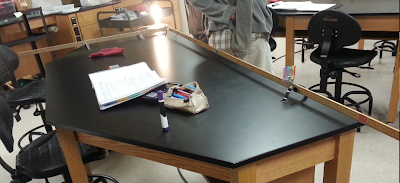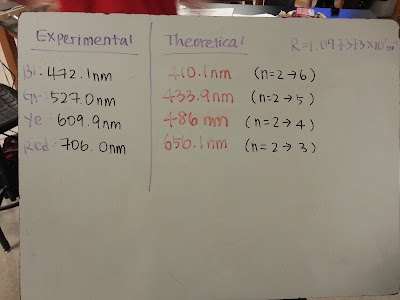Physics 4C HJJPark
Wednesday, June 12, 2013
Project. Titanium Dioxide Solar Cell.
<Dye-Sensitized Titanium Dioxide Solar Cell>
Lab member : Janice Park, Leon Du
Introduction
Also, the demanding electricity (energy) is keep growing; so that in 2100, about 4 times more resources will be required to sustain decent living conditions.
However, these sources are limited. The reserved oil, natural gas, and coals will be gone in 50 years from now.
Also, the bi-product of these fossil pollute the earth, which resulted in dramatic increase of earth temperature.
The solar energy has potent to being next generation energy source.
The goal of this project is to develop titanium dioxide solar cell, which is cost effective, use of organic dye (chlorophyll, blackberries, and raspberries) to improve the energy efficiency.
Schematic of basic Titanium Dioxide solar cell
Chemical reaction of dye with solar cell's mechanism
Materials
Procedure
Result/Discussion
Please refer my partner's blogger : http://physics4chaodu.blogspot.com
Wednesday, May 29, 2013
Lab 16. Planck's Constant rom an LED
Introduction
In this experiment, the known value of Planck's constant was calculated from experimental measurement using different colors of LEDs.
Procedure
Data/Discussion
Summary
In this experiment, the known value of Planck's constant was calculated from experimental measurement using different colors of LEDs.
Procedure
 |
| Circuit was built similar to above scheme. |
 |
| Different LED light bulbs were used: yellow and blue |
 |
| Green and Red LED lights |
Data/Discussion
Summary
Since the white LED light appeared as multiple color bands on its spectrum, the white LED have a mixture of colors. The wavelength and voltage is inversely proportional to each other. The graph that plotted voltage vs. 1/wavelength gave the relationship of y = 2187.7x -1.341. The slope represents for hc/E.The percent error of this experiment is about 1.75%. This suggested that the experimental procedure is consistent, which resulted in accurate planck's constant, h.
Tuesday, May 28, 2013
Lab 15. Color and Spectra
Introduction
In this experiment, we measured the wavelength of spectrum that created by white light and colored lights.
Procedure
PART 1. The spectrum of White Light
In this experiment, we measured the wavelength of spectrum that created by white light and colored lights.
Procedure
PART 1. The spectrum of White Light
Experimental set up.
Spectrum observed through grating.
Distance of violet and red band from the light source were measured.
PART 2. Spectra of Hydrogen Gas
Light source is replaced with hydrogen gas tube.
Measure the distance of 4 primary lines of hydrogen spectrum appeared from the light source (Blue, Green, Yellow, and Red)
Data/Discussion
PART 1. Spectrum of White Light
Distance of violet and red band from the white light source, and the wavelength was calculated.
Calibration. The equation was derived by comparing the experimental values and theoretical values.
The violet was closest to the light bulb and red color is the furthest from the light bulb. The color bands were appeared in order of inverse rainbow color: violet, blue, green, yellow, orange, red.
PART 2. Spectra of a Hydrogen Gas
Distance of light bands were measured and wavelength was calculated.
Using the relationship of calibration that obtained from part 1, the adjusted wavelength was obtained.
The % Error was calculated by comparing experimental values to theoretical values. The blue band has 15% error, green band has 21.5% error, yellow band has 25.5% error, and red band has 7.6% error.
Uncertainty of measurement was not considered as a single factor, because the experimental values were averaged 2 or 3 different trials together.
Summary
The spectrum that created by different light source was different in terms of color of bands, width of bands, and number of colors on spectrum. The white light showed continuous rainbow color spectrum while the hydrogen tube showed only 4 colors and very thin bands on its spectrum.
Monday, May 27, 2013
Lab 13. Relativity of Time and Length
PART 1. Time Dilution
1.
1.
Answer : The distance traveled by the light pulse on the moving light clock is longer than the distance traveled by the light pulse on the stationary light clock.
2.
Answer : The time interval for the light pulse on the moving light clock is longer than the stationary light clock.
3.
Answer : The light pulse traveled a larger distance when the clock is moving. The moving time frame required same time interval to stationary frame.
4.
Answer : There will be no difference in light pulse travel time. They always stayed same.
5.
Answer :The light will take about 8 us to travel back and forth between mirrors.
6.
Answer : The Lorentz factor will be 1.124.
PART 2. Length Contraction
1.
Answer : The measurement of this round-trip time interval does not depend on whether the light clock is moving or stationary relative to the earth.
2.
Answer : The round-trip time interval for the light pulse as measured on the earth be longer than the time interval measured on the light clock.
3.
Answer : The round-trip time interval as measured on the earth will be smaller than the product of the Lorentz factor.
4.
Answer : The length will be 769 m.
Lab 12. Polarization of Light
Introduction
In this experiment, we observed the change in light intensity of light passing through crossed polarizing filter, which remove all but electric fields. This experiment focuses only on the electric field variation. We also measured the transmission of light through two polarizing filters as a function of the angle between their axes and compare it to Malus's Law.
Preliminary Questions
1. When one filter is at right angles to the other filter, anything can be seemed through both filters.
2. When two filters' axes were parallel to each other, increasing of angle(0° - 180°) will give the increasing of transmitted light intensity.
Procedure
PART 1. Two polarizers
In this experiment, we observed the change in light intensity of light passing through crossed polarizing filter, which remove all but electric fields. This experiment focuses only on the electric field variation. We also measured the transmission of light through two polarizing filters as a function of the angle between their axes and compare it to Malus's Law.
Preliminary Questions
1. When one filter is at right angles to the other filter, anything can be seemed through both filters.
2. When two filters' axes were parallel to each other, increasing of angle(0° - 180°) will give the increasing of transmitted light intensity.
Procedure
PART 1. Two polarizers
Set two polarizers to be parallel to each others (0° & 0°), and rotate the second polarizer only with ~7.5° clockwise direction and measure the light intensity.
PART 2. Three Polarizer
Set first and third polarizers to be parallel to each others, and rotate the second polarizer by 7.5° clockwise direction and record the light intensity.
Data
PART 1.
PART 2.
Discussion/Analysis
PART 1.
1.
2.
3.
4. When two polarizers were parallel to each other, the minimal lights were passing through. Therefore, the intensity would be minimal as well, which close to zero. Whereas, when two polarizers were perpendicular to each other, the maximal lights were passing through; which allowed maximum intensity. The measurement of part 1 started with perpendicular axis of two polarizer; so that it showed highest values of intensity.
PART 2.
1 & 2.
3.
Polarization upon Reflection
1. The light from the fluorescent bulb does not have any polarization.
2. The reflected light have polarization. The light will be polarized in parallel plane.
Subscribe to:
Comments (Atom)

















































